Cosmic Radiation
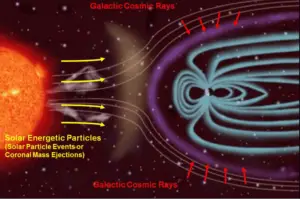
Cosmic radiation refers to sources of radiation in the form of cosmic rays that come from the Sun or from outer space. The earth has always been bombarded by high-energy particles originating in outer space that generate secondary particle showers in the lower atmosphere. Charged particles (especially high-energy protons) from the sun and outer space interact with the earth’s atmosphere and magnetic field to produce a shower of radiation (i.e. air shower), typically beta and gamma radiation. If you live at higher elevations or are a frequent airline passenger, this exposure can be significantly higher, since the atmosphere is thinner here. The effects of the earth’s magnetic field also determines the dose from cosmic radiation.
At ground level the muons, with energies mostly between 1 and 20 GeV, contribute about 75 % of the absorbed dose rate in free air. The remainder comes from electrons produced by the muons or present in the electromagnetic cascade. The annual cosmic ray dose at sea level is around 0.27 mSv (27 mrem).
Composition of Cosmic Radiation
The primary cosmic radiation consist of a mixture of high-energy protons (~87%), alpha particles (~11%), high-energy electrons (~1%) and a trace of heavier nuclei (~1%). The energy of these particles range between 108 eV and 1020 eV. A very small fraction are stable particles of antimatter, such as positrons or antiprotons. The precise nature of this remaining fraction is an area of active research.
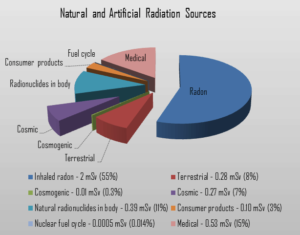 Subsequently, a large number of secondary particles, in particular, neutrons and charged pions are produced as a result of interactions between primary particles and the earth’s atmosphere. Since pions are short-lived subatomic particles, the subsequent decay of the pions result in the production of high-energy muons. At ground level the muons, with energies mostly between 1 and 20 GeV, contribute about 75 % of the absorbed dose rate in free air. The dose rate from cosmic radiation varies in different parts of the world and it depends strongly on the geomagnetic field, altitude, and solar cycle. The cosmic radiation dose rate on airplanes is so high that, according to the United Nations UNSCEAR 2000 Report, airline flight crew workers receive more dose on average than any other worker, including those in nuclear power plants.
Subsequently, a large number of secondary particles, in particular, neutrons and charged pions are produced as a result of interactions between primary particles and the earth’s atmosphere. Since pions are short-lived subatomic particles, the subsequent decay of the pions result in the production of high-energy muons. At ground level the muons, with energies mostly between 1 and 20 GeV, contribute about 75 % of the absorbed dose rate in free air. The dose rate from cosmic radiation varies in different parts of the world and it depends strongly on the geomagnetic field, altitude, and solar cycle. The cosmic radiation dose rate on airplanes is so high that, according to the United Nations UNSCEAR 2000 Report, airline flight crew workers receive more dose on average than any other worker, including those in nuclear power plants.
We also have to include the neutrons at ground level. Cosmic rays interact with nuclei in the atmosphere, and produce also high-energy neutrons. According to UNSCEAR the fluency of neutrons is 0.0123 cm-2s–1 at sea level for a geomagnetic latitude of 45 N. Based on this, the effective annual dose from neutrons at sea level and at 50 degree latitude is estimated to be 0.08 mSv (8 mrem). Noteworthy, in the vicinity of larger heavier objects, e.g. buildings or ships, the neutron flux measures higher. This effect is known as “cosmic ray induced neutron signature”, or “ship effect” as it was first detected with ships at sea. Cosmic rays create showers in the atmosphere that include a broad spectrum of secondary neutrons, muons and protons. The secondary neutrons may be of a very high energy and may induce spallation events in materials at ground level. Therefore in the vicinity of larger heavier objects, these multiple neutrons produced in spallation events are referred to as “ship effect” neutrons.
Neutrons produced in the upper atmosphere are also responsible for generation of radioactive carbon-14, which is the best known cosmogenic radionuclide. Carbon-14 is continuously formed in the upper atmosphere by the interaction of cosmic rays with atmospheric nitrogen. On average just one out of every 1.3 x 1012 carbon atoms in the atmosphere is a radioactive carbon-14 atom. As a result, all living biological substances contain the same amount of C-14 per gram of carbon, that is 0.3 Bq of carbon-14 activity per gram of carbon. As long as the biological system is alive the level is constant due to constant intake of all isotopes of carbon. When the biological system dies, it stops exchanging carbon with its environment, and from that point onwards the amount of carbon-14 it contains begins to decrease as the carbon-14 undergoes radioactive decay.
Energy of Cosmic Rays
The energies of the most energetic ultra-high-energy cosmic rays (UHECRs) have been observed to approach 3 x 1020 eV, about 40 million times the energy of particles accelerated by the Large Hadron Collider. The origin of the high energy particles is from outer space. It is assumed that particles with an energy up to about 1015 eV are coming from our own galaxy, whereas those with the highest energies probably have an extragalactic origin.
Classification of Cosmic Radiation
Cosmic radiation can be divided into different types according to its origin. There are three main sources of such radiation:
- Solar Cosmic Radiation. Solar cosmic radiation refers to sources of radiation in the form of high-energy particles (predominantly protons) emitted by the sun, primarily in solar particle events (SPEs).
- Galactic Cosmic Radiation. Galactic cosmic radiation, GCR, refers to sources of radiation in the form of high-energy particles originating outside the solar system, but generally from within our Milky Way galaxy.
- Radiation from Earth’s Radiation Belts (van Allen belts). Van Allen radiation belts are zones of high-energy particles (especially protons) trapped by earth’s magnetic field.
Galactic Cosmic Radiation
Galactic cosmic radiation, GCR, refers to sources of radiation in the form of high-energy particles originating outside the solar system. GCR are high-energy nuclei from which all of the surrounding electrons have been stripped away during their high-speed passage through the galaxy. The GCR incident on the upper atmosphere consist of a nucleonic component, which aggregate accounts for 98% of the total (2% are electrons). The nucleonic component then consist of a mixture of high-energy protons (~86%), alpha particles (~12%), and a trace of heavier nuclei (~1%). GCR are trapped by the galactic magnetic field, therefore they have probably been accelerated within the last few million years, and have traveled many times across the galaxy. Their acceleration mechanism is uncertain, but one of possible mechanisms is that the particle are accelerated by shock waves expanding from supernovas. The energy of these particles range between 108 eV and 1020 eV. A very small fraction are stable particles of antimatter, such as positrons or antiprotons.
The precise nature of this remaining fraction is an area of active research. The GCR fluence rate varies with solar activity, being lower when solar activity is higher. At solar minimums, due to lower solar magnetic field shielding, the fluence is significantly higher than at solar maximum.
Solar Cosmic Radiation – Solar Particle Event
Solar cosmic radiation refers to sources of radiation in the form of high-energy particles (predominantly protons) emitted by the Sun, primarily in solar particle events (SPEs). The solar radiation incident on the upper atmosphere consist mostly of protons (99%), with energies generally below 100 MeV. Solar particle events, for example, occur when protons emitted by the Sun become accelerated either close to the Sun during a flare or in interplanetary space by coronal mass ejection shocks. Note that, the Sun has an 11-year cycle, which culminates in a dramatic increase in the number and intensity of solar flares, especially during periods when there are numerous sunspots.
Solar radiation is a significant radiation hazard to spacecraft and astronauts, also produces significant dose rates at high altitudes, but only the most energetic radiation contribute to doses at ground level. Note that, anyone who had been on the Moon’s surface during a particularly violent solar eruption in 2005 would have received a lethal dose.
Radiation from Earth’s Radiation Belts – Van Allen belts
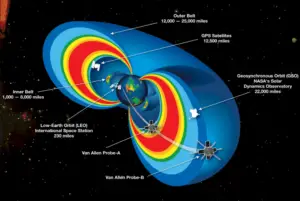
Van Allen radiation belts are zones of high-energy particles (especially protons) trapped by earth’s magnetic field. Most of these high-energy particles originate from the solar wind, that were captured by and held around a planet by that earth’s magnetic field. The van Allen belt is formed like a torus above the equator. There are two van Allen radiation belts, an internal belt is centered at about 3,000 kilometers and an outer belt is centered at about 22,000 kilometers from the earth’s surface. It contains mainly energetic protons in the 10-100 MeV range.
Spacecraft travelling beyond low Earth orbit enter the zone of radiation of the Van Allen belts. Beyond the belts, they face additional hazards from cosmic rays and solar particle events. A region between the inner and outer Van Allen belts lies at two to four Earth radii and is sometimes referred to as the “safe zone”.
Dose Rate in Airplane – Radiation in Flight
Exposure to cosmic radiation increases rapidly with altitude. In flight there are two principal sources of natural radiation to consider: Galactic Cosmic Rays which are always present, and Solar Proton Events, sometimes called Solar Cosmic Ray (SCR) events, which occur sporadically. The dose rate from cosmic radiation varies in different parts of the world and it depends strongly on the geomagnetic field, altitude, and solar cycle. The radiation field at aircraft altitudes consist of neutrons, protons and pions. In flight, neutrons contribute 40 – 80% of the equivalent dose, depending on the geomagnetic field, altitude, and solar cycle. The cosmic radiation dose rate on airplanes is so high (but not dangerous) that, according to the United Nations UNSCEAR 2000 Report, airline flight crew workers receive more dose on average than any other worker, including those in nuclear power plants.
The ground level dose rate is on average about 0.10 μSv/h, but at the maximum flight altitude (8.8 km or 29,000 ft) it can reach about 2.0 μSv/h (or even higher values). A dose rate of 4 μSv/h may be used to represent the average dose rate for all long haul flights (due to higher altitudes). It must be added, for supersonic planes like the Concorde, that could make a transatlantic flight in 3.5 hours, the exposure rate (about 9 μSv/h) at their altitude of 18 km was increased enough to result in the same cosmic ray exposure per crossing as for conventional jets trundling along at about 8 km.
Shielding of Cosmic Radiation
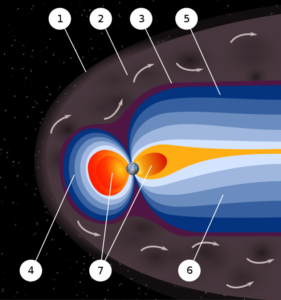
Earth’s magnetic field provides a vital radiation shield of cosmic radiation. In addition to a protective atmosphere, we are also lucky that Earth has a magnetic field. Magnetic field extends several tens of thousands of kilometers into space, protecting the Earth from the charged particles of the solar wind and cosmic rays that would otherwise strip away the upper atmosphere, including the ozone layer that protects the Earth from harmful ultraviolet radiation. It shields us from the full effects of the solar wind and GCR. Without this protection, Earth’s biosphere might not exist as it does today, or would be at least limited to the subsurface. Earth’s magnetic field provides also a radiation shield for astronauts and the ISS itself, because it is in low Earth orbit.
Calculations of the loss of carbon dioxide from the atmosphere of Mars, resulting from scavenging of ions by the solar wind, indicate that the dissipation of the magnetic field of Mars caused a near total loss of its atmosphere.
Cosmic Radiation – Is it dangerous?
We must emphasize, eating bananas, working as airline flight crew or living in locations with, increases your annual dose rate. But it does not mean, that it must be dangerous. In each case, intensity of radiation also matters. It is very similar as for heat from a fire (less energetic radiation). If you are too close, the intensity of heat radiation is high and you can get burned. If you are at the right distance, you can withstand there without any problems and moreover it is comfortable. If you are too far from heat source, the insufficiency of heat can also hurt you. This analogy, in a certain sense, can be applied to radiation also from radiation sources.
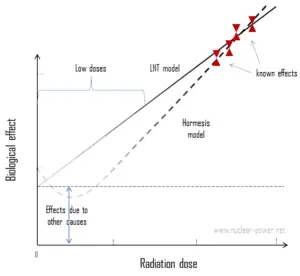
In case of radiation from cosmic rays, we are talking about so called “low doses”. Low dose here means additional small doses comparable to the normal background radiation (10 µSv = average daily dose received from natural background). The doses are very very low and therefore the probability of cancer induction could be almost negligible. Secondly, and this is crucial, the truth about low-dose radiation health effects still needs to be found. It is not exactly known, whether these low doses of radiation are detrimental or beneficial (and where is the threshold). Government and regulatory bodies assume a LNT model instead of a threshold or hormesis not because it is the more scientifically convincing, but because it is the more conservative estimate. Problem of this model is that it neglects a number of defence biological processes that may be crucial at low doses. The research during the last two decades is very interesting and show that small doses of radiation given at a low dose rate stimulate the defense mechanisms. Therefore the LNT model is not universally accepted with some proposing an adaptive dose–response relationship where low doses are protective and high doses are detrimental. Many studies have contradicted the LNT model and many of these have shown adaptive response to low dose radiation resulting in reduced mutations and cancers. This phenomenon is known as radiation hormesis.
We hope, this article, Cosmic Radiation – Cosmic Ray, helps you. If so, give us a like in the sidebar. Main purpose of this website is to help the public to learn some interesting and important information about radiation and dosimeters.